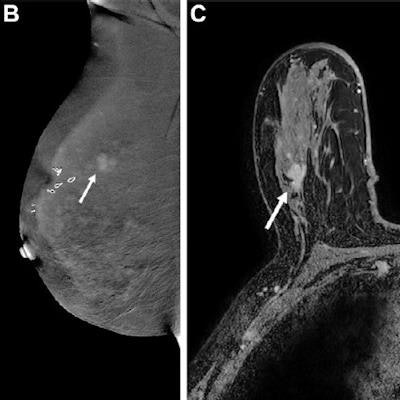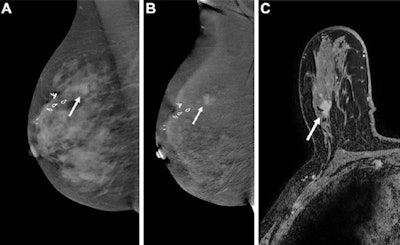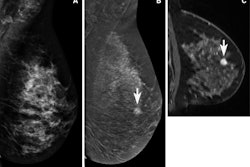
Abbreviated MRI is on par with standard breast MRI while contrast-enhanced mammography (CEM) has its share of tradeoffs in breast cancer screening, a study published August 15 in Radiology found.
A team led by Marissa Lawson, MD, from the University of Washington in Seattle found that abbreviated breast MRI had comparable performance to standard MRI. Meanwhile, CEM had lower recall and higher specificity compared to both MRI methods but also had lower cancer detection rate and sensitivity.
"Our study results found no statistically significant difference between abbreviated breast MRI and standard MRI protocols, suggesting that abbreviated breast MRI may be a comparable alternative for high-risk screening, with the benefit of increased efficiency and potentially lower cost compared with standard MRI," Lawson and colleagues wrote.
When it comes to supplemental breast imaging to confirm suspicious mammography findings, MRI has been heralded for its high sensitivity in detecting malignancies. However, breast MRI is also less accessible than other imaging modalities in this area, owing to longer image acquisition and interpretation times, higher cost, and lower patient tolerance. This has led to breast imagers seeking alternatives to standard MRI in this area.
While the performances of abbreviated breast MRI and CEM have been investigated, Lawson et al pointed out a lack of data on direct comparative performances between the two, as well as against standard breast MRI. They wanted to evaluate the comparative diagnostic performance of the three modalities based on American College of Radiology (ACR) accreditation standards.
 CEM images (A, B) and an MRI scan (C) show true-positive findings in a 73-year-old woman with a personal history of right breast ductal carcinoma in situ (DCIS) treated with lumpectomy and newly diagnosed left breast invasive lobular carcinoma (not shown), who presented for contralateral right breast screening. (A) Mediolateral oblique low-energy and (B) mediolateral oblique recombined CEMs of the right breast show an irregular contrast-enhanced mass with irregular margins in the upper outer quadrant (arrows). (C) Axial contrast-enhanced breast MRI sequence shows an irregular contrast-enhanced mass with irregular margins that is suspicious for cancer in the upper outer quadrant of the right breast (arrow). Pathology revealed recurrent invasive ductal carcinoma and DCIS, Nottingham grade I, that was estrogen receptor positive, progesterone receptor positive, and human epidermal growth factor receptor 2 (HER2) receptor negative. Images courtesy of RSNA.
CEM images (A, B) and an MRI scan (C) show true-positive findings in a 73-year-old woman with a personal history of right breast ductal carcinoma in situ (DCIS) treated with lumpectomy and newly diagnosed left breast invasive lobular carcinoma (not shown), who presented for contralateral right breast screening. (A) Mediolateral oblique low-energy and (B) mediolateral oblique recombined CEMs of the right breast show an irregular contrast-enhanced mass with irregular margins in the upper outer quadrant (arrows). (C) Axial contrast-enhanced breast MRI sequence shows an irregular contrast-enhanced mass with irregular margins that is suspicious for cancer in the upper outer quadrant of the right breast (arrow). Pathology revealed recurrent invasive ductal carcinoma and DCIS, Nottingham grade I, that was estrogen receptor positive, progesterone receptor positive, and human epidermal growth factor receptor 2 (HER2) receptor negative. Images courtesy of RSNA.In their single-institution, prospective, blinded reader study, the researchers included women who were referred for breast MRI between 2018 and 2021. CEM was performed within 14 days of standard MRI, while abbreviated MR images were produced from standard MR images. Two readers independently interpreted each CEM and abbreviated MR image after a washout period.
In total, the team included 492 paired CEM and abbreviated MRI interpretations from 246 women with a median age of 51 years. It also reported that on 49 MRI scans with lesions recommended for biopsy, nine lesions showed malignant pathology.
The researchers found that while abbreviated MRI showed no significant differences in performance metrics with standard MRI, CEM varied in performance.
| Comparative performance between MRI, abbreviated MRI, and CEM | |||
| Parameter | Standard MRI | Abbreviated MRI | CEM |
| Recall rate | 22.8% | 26.6% | 14% |
| Cancer detection rate per 1,000 exams | 36.6 | 32.5 | 22.41 |
| Biopsy recommendation rate per 1,000 exams | 162.6 | 180.9 | 65 |
| Positive predictive value | 18.41 | 14.4 | 22 |
| Sensitivity | 100% | 88.9% | 61.1% |
| Specificity | 80.2% | 75.7% | 87.8% |
The researchers also found that four women who participated in the study and were administered an intravenous iodinated contrast agent experienced adverse reactions. Their reactions were reported to be mild based on ACR categorization, limited to rash and hives that did not require treatment.
The study authors highlighted that although their research "may have been underpowered" to find small differences in performance metrics, their results are consistent with meta-analyses evaluating the performance of abbreviated MRI versus standard MRI.
Additionally, the authors wrote that while their meta-analyses did not report lesion characteristics, these may have impacted CEM's sensitivity in their study. They called for future studies with larger sample sizes to investigate CEM's tradeoffs, as well as patient acceptance.
"In addition, our MRI protocol has spatial resolution that exceeds [ACR] accreditation standards, which likely facilitates superior depiction of lesions compared with CEM," the authors wrote.
The study can be found in its entirety here.
In an accompanying editorial, Jung Min Chang, MD, PhD, from Seoul National University Hospital in South Korea wrote that while test performance among modalities is important, it is not the only factor that determines which is best for certain women. She wrote that choosing supplemental screening method varies based on the healthcare environment, characteristics of the target women, and cancer prevalence.
"Despite having lower cancer detection rates than standard MRI or abbreviated breast MRI, CEM may be beneficial for patients in whom MRI is not readily available, making it a valuable addition to the radiologic arsenal," Chang wrote.




















